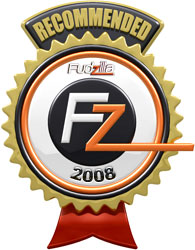Testbed:
Motherboard:
EVGA 680i SLI (Supplied by EVGA)
Processor:
Intel Core 2 Duo 6800 Extreme edition (Supplied by Intel)
Memory:
OCZ FlexXLC PC2 9200 5-5-5-18 (Supplied by OCZ)
during testing CL5-5-5-15-CR2T 1066MHz at 2.2V
PSU:
OCZ Silencer 750 Quad Black (Supplied by OCZ)
Hard disk:
Seagate Barracuda 7200.9 80GB SATA (Supplied by Seagate)
CPU-Cooler:
Freezer 7 Pro (Supplied by Artic Cooling)
Case Fans:
Artic Cooling - Artic Fan 12 PWM
Artic Cooling - Artic Fan 8 PWM
Futuremarks

Two 9600 GT GS cards scored similarly, but 512MB card was a bit better. Gainward 9600 GT GS cards are factory overclocked, and therefore better than reference 9600 GT. Overclocking Golden Sample cards is easy, and 9600 GT 1024MB at 805MHz scored 11508 marks in 3DMark06.
Overclocking
You probably heard that there are two ways to overclock your Geforce 9600 card. One of them is the standard one, increase the frequencies within the driver or a certain utility; whereas the other one is overclocking the PCIe bus. Regularly increasing bus frequencies should only result in bandwidth improvement, but that didn’t happen with 9600 GT cards. Higher frequencies of PCIe slots will automatically raise the card speed. However, ForceWare driver doesn’t list these changes so you won’t even know that your card runs faster. On the other hand, gaming will score better results. This kind of overclocking can easily be done on certain motherboards that automatically raise PCIE frequencies, and the worst case scenario results in the system not booting because the graphics card can’t run at set speeds.
We managed to push it up to 805MHz using the drivers, and managed to perform all the testing except for Crysis at 1600x1200. We then downclocked it to 792MHz where it ran stable. This is 13% higher overclock on top of already high 700MHz. Compared to reference 650MHz, total overclock amounts to 21%. Memory ran stable at 1069MHz (2138MHz effectively). You can take a look at overclocking results in our tables, and they’re labeled Gainward 9600 GT GS/1024MB OC.
We now move on to overclocking the PCIe bus. Standard frequency is 100MHz so each additional push will affect Geforce 9600 GT results. We first manually set the PCIe bus speed to 100MHz, and then to 120MHz. What happened? Well, the system couldn’t boot properly and kept restarting. 20MHz more on the PCIe bus results in 20% faster card, but our computer couldn’t boot because 9600 GT couldn’t take those speeds.
Step two was trying our luck with 110MHz. This resulted in the card’s GPU running 10% faster, and that went without a hitch. The speed was 770MHz. However, the results we got when using the driver to overclock the GPU to 792MHz were slightly better. On the other hand, this clearly shows that you can use your PCIe bus to overclock the card, without even using your drivers.

Gaming
We didn’t use PCIe bus overclocking in our further game testing. We stuck to the “old ways” and used the RivaTuner to overclock the frequency to stable 792MHz. No problems arose with the memory either, and it ran at 1069MHz (2138MHz effectively).
Two Golden Sample 9600 GT cards score similarly in Company of Heroes, but 1024MB card has a slight advantage and scores 4% better than Golden Sample 512MB card. Compared to reference card, 9600 1024MB GS card scores up to 12%. Additional 92MHz overclock resulted in beating the reference card by almost 26%.


Additional memory pays off only at 1600x1200 with AA and AF on, but that still didn’t result in playable fps. Still, overclocked card result was nice, and almost comparable to 8800 GT’s result.

For F.E.A.R., 512MB will be more than enough. After overclocking, we got up to 10% better results compared with Gainward GT GS 512MB, and up to 17% better than reference 9600 GT.
Conclusion
We tested Gainward 9600 GT 1024MB Golden Sample card that comes factory overclocked to 700Mhz. The memory runs at 1000MHz (2000MHz effectively), whereas the stream processors run at 1750MHz. These are quite high speeds for an 1024MB card, but it’s the overclocking potential that really packs some punch.
Additional memory will rarely benefit current games, but if you do video processing or intend to use it elsewhere where more memory is required – then it should be a great choice. The card offers many outs, and this is the first card that offers DisplayPort, HDMI and two dual link DVIs on one place.
Gainward Geforce 9600 GT 1024MB Golden Sample supports DirectX 10, Shader Model 4.0, OpenGL 2.1 and the aforementioned DisplayPort. It has a dual slot cooler and enough muscle to enable for pleasant gaming and HD video viewing and processing. The price, on the other hand, isn’t its greatest point, but it will be hard to find better 1024MB card at €173.
We recommend this card to anyone who wants the best that 9600 GT cards offer, because not only do you get an overclockable card and 512MB of additional memory, but also DisplayPort and HDMI.

